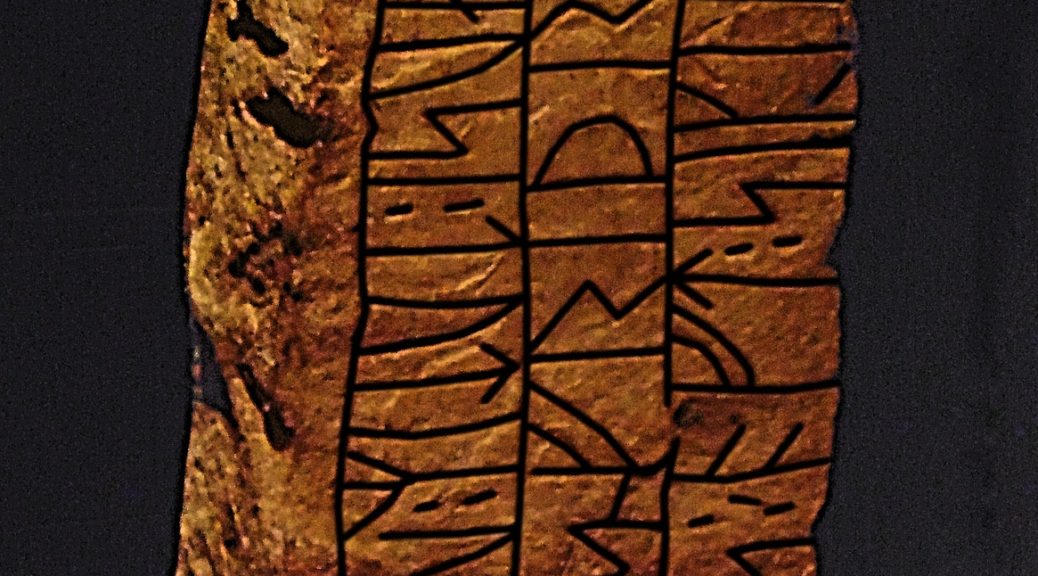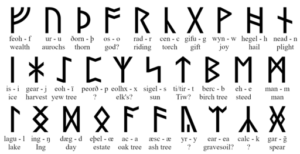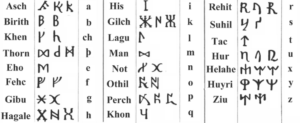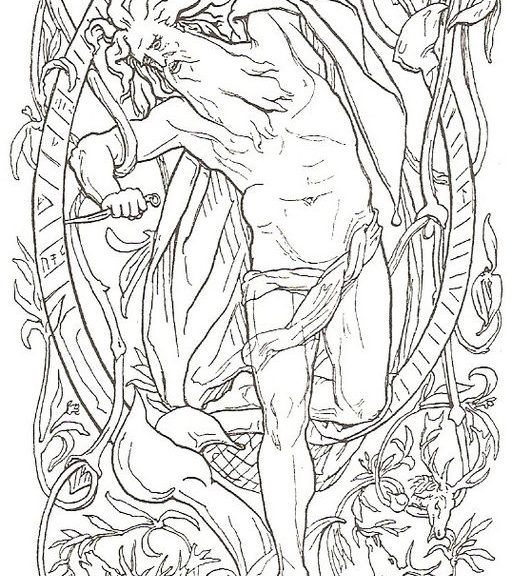The Elder Futhark: Raidho
The fifth rune of Freyr’s ætt is Raidho, which corresponds to “R” in the Latin alphabet (the alphabet we use). If you haven’t noticed the similarity between the other runes I’ve shown and our own alphabet, you probably will see it in Raidho and our letter R. Whether our runes were based on an older form of the Latin alphabet or whether they evolved from an older Indo-European alphabet is up for conjecture. If you want to read about the origin of the runes, you can do that HERE.
Raidho‘s Meaning
In Anglo-Saxon Raidho is Rad and in Old Norse it is Reid. Raidho is the rune of travel. It means a wheel, cart, chariot, or journey. Our ancestors considered travel very important because it required a fair amount of effort to go someplace. When you’re limited to walking, snowshoes, carts, travel using animals, or ships, you had a fair amount of effort involved, both physically and mentally. You left your safe confines of home to journey into less safe territory and unknown lands. Like any travel, it could be good or bad.
Divination with Raidho
When you get this rune in a casting, you’re looking at movement, whether physically, emotionally, or mentally. It can mean something like business and vacation travel when dealing with physical movement. It could mean an actual move or change in residence. Or it could mean changes in perspective when it comes to a situation, relationship, or point-of-view.
Raidho often means leaving something that you know for somewhere you aren’t necessarily familiar with. It can be scary, if you’re not ready for it, or it might be a welcome change you’ve been looking for. Regardless, Raidho means movement, and that means it can provide either good or bad, depending on the matter under consideration.
You may notice I caveat a lot of rune readings by saying the meaning depends a lot on the runes surrounding the rune in question. The runes feed off of each other, creating a broader picture for the caster. Raidho is no different in that regard. You may find that Raidho foretells of a job opportunity–or it could foretell of a layoff–depending on the runes surrounding it and the circumstance.
Some Final Thoughts on Raidho
Raidho is one of those runes I actually like. Not because I hate being in the spot I’m in, but more because it can provide opportunities I would normally miss if everything continued to stay the same. Sure, it can bring negative consequences, but the times I’ve seen Raidho in a cast, it usually indicates physical travel for me–and usually something I’ve been expecting. You may find Raidho to be like that, or maybe it speaks more to your mental or emotional state. Regardless, it is a rune of change, both good and bad.
—
Disclaimer: This post contains affiliate links. If you purchase something from these links, I get a small stipend which helps support The Rational Heathen. I would encourage you to support my site. Thanks.







 Uruz is an interesting rune to have in a cast because it is the symbol of vitality and strength. In many ways, it’s a positive rune to have, depending on where it is in the layout and what runes are surrounding it. If Uruz is in a place in the cast which is what obstacles you might face, then it can be an unwanted rune, because it may be saying that the forces against you achieving your goal are powerful and may be difficult, if not insurmountable, to overcome. But in many casts, it suggests a strong force helping you. But be careful, Uruz can bring about some pretty powerful changes that you might not foresee, and your life can become chaotic with such a rune at the helm.
Uruz is an interesting rune to have in a cast because it is the symbol of vitality and strength. In many ways, it’s a positive rune to have, depending on where it is in the layout and what runes are surrounding it. If Uruz is in a place in the cast which is what obstacles you might face, then it can be an unwanted rune, because it may be saying that the forces against you achieving your goal are powerful and may be difficult, if not insurmountable, to overcome. But in many casts, it suggests a strong force helping you. But be careful, Uruz can bring about some pretty powerful changes that you might not foresee, and your life can become chaotic with such a rune at the helm.


 The Elder Futhark are the oldest runes we know about, having been around between 150 and 800 CE or AD. These runes were first used by Germanic tribes in Northern Germany, Norway, Sweden, and Denmark. Called the Elder Futhark because the first letters of the alphabet are F U TH A R and K. (There’s your answer for Trival Pursuit, Norse Style. You’re welcome.)
The Elder Futhark are the oldest runes we know about, having been around between 150 and 800 CE or AD. These runes were first used by Germanic tribes in Northern Germany, Norway, Sweden, and Denmark. Called the Elder Futhark because the first letters of the alphabet are F U TH A R and K. (There’s your answer for Trival Pursuit, Norse Style. You’re welcome.) Branch runes while the Norwegian-Swedish runes are called the Short-Twig or Rök runes. These runes came into being around the 8th century to about the 12th century, when the Latin alphabet took over.
Branch runes while the Norwegian-Swedish runes are called the Short-Twig or Rök runes. These runes came into being around the 8th century to about the 12th century, when the Latin alphabet took over. The Anglo-Saxon runes or Anglo-Frisian runes are collectively known as the Futhorc because those are the first letters of that runic alphabet. The earliest form of the Futhorc looked almost exactly like the Elder Futhark with three more runes in the 5th century. By the 7th century, most of the Anglo-Saxon runes had been replaced by the Latin alphabet, but it was still used occasionally up until the 12th century.
The Anglo-Saxon runes or Anglo-Frisian runes are collectively known as the Futhorc because those are the first letters of that runic alphabet. The earliest form of the Futhorc looked almost exactly like the Elder Futhark with three more runes in the 5th century. By the 7th century, most of the Anglo-Saxon runes had been replaced by the Latin alphabet, but it was still used occasionally up until the 12th century. Elder Futhark and Futhorc runes. The manuscript was drawn up in the southern part of the Carolingian Empire, around Bavaria. These runes are supposedly in use in the 8th and 9th centuries.
Elder Futhark and Futhorc runes. The manuscript was drawn up in the southern part of the Carolingian Empire, around Bavaria. These runes are supposedly in use in the 8th and 9th centuries. Although Scandinavia was now Christianized, people still used runes, blending them with the Latin alphabet. They were used between the 12th and 15th centuries.
Although Scandinavia was now Christianized, people still used runes, blending them with the Latin alphabet. They were used between the 12th and 15th centuries.



